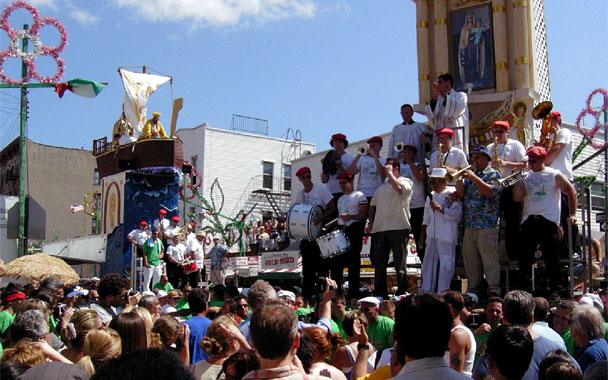The Giglio Festival—or, more properly, The Cooperative Feast of Our Lady of Mt. Carmel and San Paolino di Nola—originated in Williamsburg, Brooklyn in 1903. It’s still celebrated there for two weeks each July, the streets lined with the best Italian food carts in New York City, a modern-day Giglio at the center of it all.
Immigrants from the town of Nola, Italy, just east of Naples, started the festival to commemorate a story dating to the 5th century, in which the bishop of Nola, St. Paulinus, saved boys from the Saracens by offering himself as a hostage. When he returned from captivity, the women of the town greeted him with lilies.
Today, Brooklyn devotees construct the Giglio (“lily” in Italian), a 70-foot tower that weighs four tons, decorated with statues of Saint Paulinus, and has a porch upon which a rollicking 16-piece brass band plays. Above the band, a priest or two help to whip the crowd into a frenzy. As a tribute to the saint, a cadre of 120 neighborhood “lifters,” known as panzana, grab the poles protruding from the side of the tower and lift the edifice a few inches off the ground—band, priests, and all. Then, in response to shouted directions from their leader, they “dance” the Giglio forwards and backwards. As the tall white tower quavers in the air, the crowd oohs and aahs and yells words of encouragement. Simultaneously, other religious towers are also danced in response, including one configured like a boat that commemorates the Turkish sultan who intervened with the Saracens on behalf of the saint.
To enhance the spectacle, food carts dish out Southern Italian festival fare, adapted to its American context. There are zeppoles galore; these spherical donuts, dusted with lavish amounts of powdered sugar, often come from the same carts that make deep-fried calzones. Hot and sweet sausages are cooked on flat griddles with onions and sweet peppers and are served in a length of Italian bread. (This kind of bread never existed in Italy; Italian-American bakers created it in response to a baguette craze that swept the United States in the 1920s.)
My favorite cart is Fasullo’s, which also appears at other street festivals in New York City throughout the summer. The long white cart not only produces sausage heroes in abundance, but also cooks other meats over a charcoal fire in an attached trough. Sweetbreads receive this treatment, which renders them smoky and crisp. Even better is bracciole (pronounced, in the clipped Italian-American dialect, “braah-zhole”), a beef cutlet wrapped around cheese and parsley. Back in Calabria, where the dish originated, it is often braised in tomato sauce. At Fasullo’s, it’s grilled over the charcoal flame, dumped in an Italian “baguette,” and smothered with peppers and onions. Further betraying its Calabrian origins, Fasullo’s also grills the wonderful long, green chiles beloved in that region. These peppers are seriously spicy, and a tub of them is available to be added to the sandwiches, or eaten as snacks. It’s the perfect thing to help Giglio-watchers empathize with the panzana as they hoist the heavy tower in the hot sun of early July.


